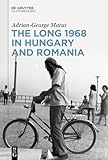The Long 1968 in Hungary and Romania / Adrian-George Matus.
Material type: TextPublisher: München ; Wien : De Gruyter Oldenbourg, [2023]Copyright date: ©2024Description: 1 online resource (XII, 289 p.)Content type:
TextPublisher: München ; Wien : De Gruyter Oldenbourg, [2023]Copyright date: ©2024Description: 1 online resource (XII, 289 p.)Content type: - 9783111253091
- 9783111273488
- 9783111272931
- 303.48/409439 23/eng/20240214
- HN420.5.Z9 S6263 2024
- online - DeGruyter
- Issued also in print.
| Item type | Current library | Call number | URL | Status | Notes | Barcode | |
|---|---|---|---|---|---|---|---|
 eBook
eBook
|
Biblioteca "Angelicum" Pont. Univ. S.Tommaso d'Aquino Nuvola online | online - DeGruyter (Browse shelf(Opens below)) | Online access | Not for loan (Accesso limitato) | Accesso per gli utenti autorizzati / Access for authorized users | (dgr)9783111272931 |
Browsing Biblioteca "Angelicum" Pont. Univ. S.Tommaso d'Aquino shelves, Shelving location: Nuvola online Close shelf browser (Hides shelf browser)

|

|

|

|

|

|

|
||
| online - DeGruyter Leading Impactful Teams : Achieving Low-Stress Success in Project Management / | online - DeGruyter Karl Barth on Faith : A Systematic Exploration / | online - DeGruyter Turning Points : Challenges for Western Democracies in the 21st Century / | online - DeGruyter The Long 1968 in Hungary and Romania / | online - DeGruyter Kunstraub für den Sozialismus : Zur rechtlichen Beurteilung von Kulturgutentziehungen in SBZ und DDR / | online - DeGruyter Erfolgreiche Transformation von Geschäftsmodellen in disruptiven Zeiten : Der High 5 Ansatz / | online - DeGruyter Aristoteles-Kommentare und ihre Überlieferung : Wichtige Etappen von der Antike bis in die frühe Neuzeit / |
PhD European University,Florence 2022.
Frontmatter -- Preface -- Content -- Acknowledgments -- Part I: Context(s) -- 1 The Childhood of a Generation -- 2 (De)Forming Institutions -- Part II: “A Nylon Curtain”? -- 3 Media and “the Nylon Curtain” -- 4 Rocking the Socialist State through Magnets and Tape Records -- Part III: Ultra-Left and Mystical Revolutions -- 5 Unexpected Models: Lukács and Eliade -- 6 Mystical Revolution in Romania -- 7 General Conclusions -- Appendix A – List of Names -- Appendix B – Primary Sources Description -- References -- Index
restricted access online access with authorization star
http://purl.org/coar/access_right/c_16ec
This book advances a local, regional, and comparative analysis of the history of the sixty-eighters from Hungary and Romania between 1956 and 1975. The aim of the book is to answer to the following research question: to what extent does ‘the long 1968’ mark and change protest history? Another axis of my research, equally important, is: how can one genuinely distinguish between a protest, an opposition, and a pastime? Where did radicalisation truly begin, and when was it solely an auto-perception as a dissident? In other words, how can one truly distinguish between a leisure activity like listening to Radio Free Europe or exploring an altered state of consciousness, and an explicit political activity like organising a protest or writing subversive texts? Among other aims, the books’s scope is to understand where a leisure activity ends, and a protest starts. By ‘practicing counterculture,’ did the youth wish to contest the system or simply express themselves? As method, oral history plays a crucial part. On a superficial level, the interviews helped to fill in the archival gap. However, oral testimonies proved to reveal much more than essential factual information. Oral history clarified how political and social events influenced the subjects' memory formation.
Issued also in print.
Mode of access: Internet via World Wide Web.
In English.
Description based on online resource; title from PDF title page (publisher's Web site, viewed 02. Jun 2024)


